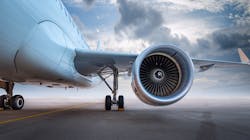Engine Controls Take Flight to a Cleaner Future
ENDICOTT, New York - Mounted to the side of a jet engine is a set of high-tech electronics roughly the size of a personal computer. These smart, digital controls pack enough punch to optimize engine performance in aircraft of all sizes, even in the harshest conditions.
They monitor and manage engine performance – reducing cost, driving efficiency, and improving safety of flight. They use a series of sensors to keep an eye on the current flight conditions and how the engine is running. The controls use that information to adjust fuel flow, air bypass, and other engine parameters to get the best performance from the engine. This technology has served as the brains of aircraft engines for decades, and it has been improved with every new generation of engines.
Improving the system
The rise in greenhouse gases has airlines considering how they can reduce aircraft emissions and save on fuel – with the eventual goal of going all-electric. While the first commercial electric-hybrid or all-electric flight may be years away, we are clearly trending in that direction. To prepare for this, we have been investing in core technologies to reduce the size and weight of our controls. This has resulted in our controls being 40 percent smaller and lighter than their original size and weight, but with 10 times the processing power.
In addition to size and power improvements, we are making our technology safer and more reliable. We are adding protections against threats you cannot see, like cyber-attacks. BAE Systems is also refining the prognostic systems to predict when a failure may occur to enable airlines to plan maintenance.
Decades of experience
We’re backing our investments with deep industry knowledge and expertise. Our first-generation engine controls took flight in the early 1990s and have logged 1.5 billion flight hours. Today, our engine controls are on more than 30,000 aircraft around the world. We stand by those products from the moment they leave our production factory until their last day of service. Our aftermarket support maintains the technology through its full lifecycle and keeps planes flying safely.
Another way we are preparing for electric flight is pairing our experience in engine controls with more than 20 years of expertise in energy management systems. BAE Systems’ electric power and propulsion technology powers more than 12,000 buses, trucks and marine vessels around the world. Those systems not only save fuel, but eliminate 250,000 tons of carbon dioxide from the air each year.
As transportation technology advances toward a greener tomorrow, the power sources for flight will change dramatically. BAE Systems is pioneering the key technologies today – and setting the standard – to get us there tomorrow.



